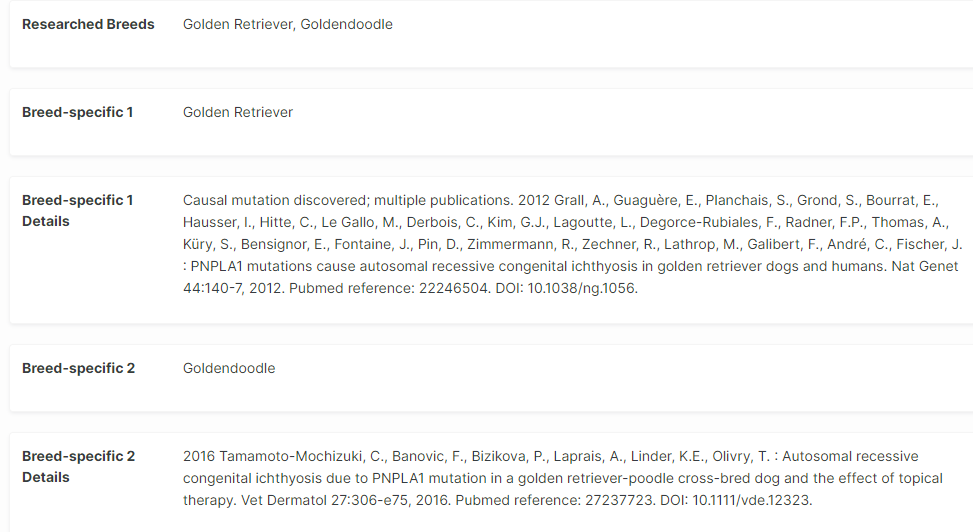HGTD This week: How Breed Relevance Ratings (BRR) are estimated for cross-breeds and ALL dogs
Breed Relevance Ratings (BRR) are a way to assess the relevance of a specific test for a specific breed, based on the currently best-known information on the research and development of a test - but genetic tests are not limited to pedigree breeds. Genetic tests are used for a variety of reasons on all dogs, and understanding the relevance is important for any purpose-bred dog or breeding program, as well as individual dogs. BRR’s are estimated for all dogs, and where the research is not available for a specific breed or type, we have processes to provide transparent information about test relevance.
How are BRRs estimated for cross-breeds?
Where a test is available to a crossbreed, but there isn't crossbreed-specific research:
If you are not yet familiar with the BRR color-code system, you can find information here. BRRs available for named crosses on the HGTD database do not assume the level of cross that has occurred – e.g. they do not assume that it is a Goldendoodle X Goldendoodle VS Golden Retriever X Standard Poodle. This is important, because research and anecdotal evidence from cross-breeders indicate that crossbreeds can vary in their crosses origin, and a 50:50 split between 2 breeds should not be assumed. This also acknowledges that some breed crosses are between similar breeds who may already share genes from before a division into distinct breeds - for example, Irish Setter and Irish Red and White Setters certainly share some historical origins. The table below gives a summary of the normal estimation of BRR where there is no cross-specific research known.
| Breed A | Breed B | Cross A x B | Comments |
|---|---|---|---|
| BRR is red or orange | BRR is red or orange | BRR may be orange, or yellow, with details in the phene/test breed-specific information | Using test may risk results that are unhelpful or detrimental in decision-making |
| BRR is green | BRR is red or orange | BRR is yellow, and may have information in the phene/test breed-specific information | Impact of test results is unknown – may or may not be informative. This test should be considered with caution. |
| BRR is yellow | BRR is yellow, or test is not available | BRR is yellow |
Impact of test results is unknown – may or may not be informative |
| BRR is green | BRR is yellow, or test is not available | BRR is normally green, with details in the phene/test breed-specific information | Test results are, on balance, likely to be informative and the test is relevant to the crossbreed |
| BRR is green | BRR is green | BRR is green, but may be at a lower-level, unless additional evidence is available. | Test results are likely to be informative and the test is relevant to the crossbreed |
For any BRR that are not able to be cross-breed specific, it is strongly recommended that you review the phene information to learn more about the disease/trait that is being tested for. The information there will be valuable to you when making a decision about the risk or importance of the test. Understanding the type of cross you have is also important. For example, if your dog is a Golden Retriever X Standard Poodle vs. Goldendoodle X Goldendoodle. If you're using a genetic test for breeding plans, this will impact the risk of inheritance in subsequent generations. The phenes database holds information on breed-specific research, and can include comments from researchers or pre-publication information that could be helpful for crossbreeds.
For example, in PRA GR PRA2, there was specific feedback from the research team that developed the test to recommend it to Goldendoodles, based on the testing already performed across Labrador Retrievers, Golden Retrievers, and Goldendoodles, as well as the original published research. Few researchers have the funding to do fully published and peer-reviewed cross-specific research for genetic tests, so the recommendation for tests with simple inheritance (e.g. Autosomal Recessive) is usually to test for any breed-specific tests in the composing breeds.
Where there is crossbreed-specific research:
The BRR is estimated in the same way as any breed. You can find information here. 
A good example of this is the genetic test for the disease “Ichthyosis, PNPLA1-related”. This is a relatively rare skin condition, that causes serious discomfort and welfare issues for a dog. The mutation was first discovered in the Golden Retriever in 2012, but was further investigated and described in golden-retriever-poodle crosses. When looking at the phene data, you can see publications for both breeds/types, in addition to the usual general description of the phene, GTPs offering the test, and other related information.
What should I do if I don't see my crossbreed listed?
New purposely bred crosses, or less common crosses, should ideally look at the breed-specific information for the breeds they are crossing when prioritizing testing information to use as part of a breeding plan, or to inform on an individual dog's risks. If considering genetic testing as part of breeding plans, it would be reasonable to be conservative, and use the breed-specific tests on the male and female being crossed to identify any genetic risks to the dogs themselves, and any genes they may pass on. In many cases, there can be genetic tests in common between breeds. These tests in common would likely be more informative on the risks for an individual dog, as well as any breeding considerations. For example, Progressive Retinal Atrophy - PRA prcd has 22 different breeds where the test is relevant (as of Dec 2020), and many more where the test is available. So, in principle any cross between those 22 different breeds should be one where the test results of PRA-prcd are considered. Where tests are not in common between two breeds being crossed, it becomes more complicated. If used in breeding plans, best practice would still recommended testing parents, and then off-spring, for all breed-specific tests for both parents. For an individual dog's risks, contacting your test provider for genetic advice or counselling may be valuable. You may find the table above useful in considering prioritizations.
What about for “ALL” dogs?
There are some tests that are available and relevant to all dogs. Examples include genetic tests that are:
- Diagnostic for a dog-wide condition (e.g. some cancer-risk tests)
- It relates to genes common to all dogs (e.g. coat colours)
- It is a genetic tool specific to an individual dog such as DNA profiling, or parentage
As inheritance in cross and mixed breeds is generally less predictable than breeds using breed-specific tests, it is important to be aware of risks, take your time to research or get advice on genetic testing. Any permanent decisions (e.g. neutering, healthcare) should be approached with especial caution and with robust veterinary and genetic counselling, with the dog’s welfare always in mind.
Any questions? As we are developing more advice and support for cross and mixed breed dogs, please feel free to contact us with any questions about genetic testing until more resources become available, at: aimee.llewellyn-zaidi@ipfdogs.com
Title image with thanks to Helena Lopes via Pexels.
 Donate
Donate
1 Comment
Recommended Comments